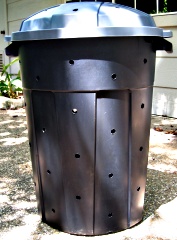I don’t know about the rest of you, but I generate a lot of kitchen scraps when I’m cooking, especially with as much fresh food as we consume now that I am able to cook more regularly. Generally speaking, these scraps either go in the trash or down the garbage disposal. For some time now, I’ve wanted to put these items to better use, and that’s why I spent part of yesterday making a simple compost bin.
Composting involves taking a variety of largely plant-based organic matter, and adding water and air to the mix in sufficient amounts to foster colonies of aerobic bacteria that break the organic matter down into dark, crumbly, nutrient-rich fertilizer for your plants. This finished compost can be used to side dress existing landscape plants, augment soil for a new garden, or be brewed into a liquid fertilizer.
A compost pile can be constructed in a variety of ways. You can build a 3’ by 3’ enclosure of wood and wire mesh that is open on the top and bottom and simply throw in your organic matter as you generate it. You could create a similar structure of stacked stones for a more aesthetically pleasing look. You could go au naturale and simply make a pile in a little used corner of your back yard. I chose to go the garbage can route. Creating a compost bin from a garbage can is a method often reserved for those without room on their property for a full-blown compost pile. In my case, I chose to go this route because we have lots of critters that hang out in the back yard (raccoons, squirrels, ‘possum, skunk, the occasional armadillo), and I’m guessing they would be very pleased to have easy access to a nice pile of kitchen scraps. The trashcan will allow me to keep my compost closed up and (relatively) safe from critter invasion.
For my bin, I purchased a dark colored 32-gallon trashcan at the local hardware store complete with a snap-on lid. I loaded the drill with a 5/8" spade bit (pictured below). Why such a strange size, you ask? Well, I borrowed it from a friend and that’s the size he was able to find. I would imagine anything from ½" to 1" would work just fine. Into the sides, top, and bottom of the trashcan, I drilled holes roughly 6" apart (center to center). I tried to stagger them somewhat to maintain the structural integrity of the trashcan. These holes will allow for the compost pile to have access to air and will also allow excess moisture to drain off.

The part I’ve not yet finished is filling it. It is generally advised to fill the can with a roughly 50/50 mix of “brown” material to “green” material. Brown materials such as fall leaves, shredded newspaper, grains, and sawdust are carbon rich. Greens such as lawn clippings, fruit and vegetable scraps, and coffee grounds are nitrogen rich. A more complete list of green and brown materials can be found here. Items you’d want to avoid putting in the pile include things like meat, dairy, oils, pet feces, and charcoal (a more complete list of items to avoid can be found at the bottom of the greens and browns page linked to above).

I will likely build the bulk of my pile here in a month or two when the leaves start to fall. In the meantime, I’ve been steadily collecting kitchen scraps in large zip-top bags in the freezer (so they don’t stink up the refrigerator as they start to rot). Once the leaves begin to fall, I’ll collect up and shred what I need and supplement with kitchen scraps. It’s important to supply the bacteria with plenty of moisture and air to go with all the food. The general guidance is to water your pile such that it thoroughly damp but not so wet that you can wring water out of it. Air can be incorporated by turning the pile once every week or two (some sites recommend this be done on a monthly basis). If the pile is behaving properly, it should get fairly warm – in the neighborhood of 130 to 140 degrees (F), and should not smell bad. If any trouble is had with the pile, a very helpful troubleshooting guide can be found here.
By building this compost bin, I am tackling several problems. First, I hate the notion of filling landfills with things that could be recycled. This will help me alleviate some of that. Second, my dry rocky soil here in central Texas could use some amending. Right now, it supports several rugged herb plants, but otherwise, my gardens aren’t able to provide much, culinarily speaking. Finally, compost is expensive and we’re on a budget. If I can make it at home with a little effort and a $13 garbage can, I’m all for it.